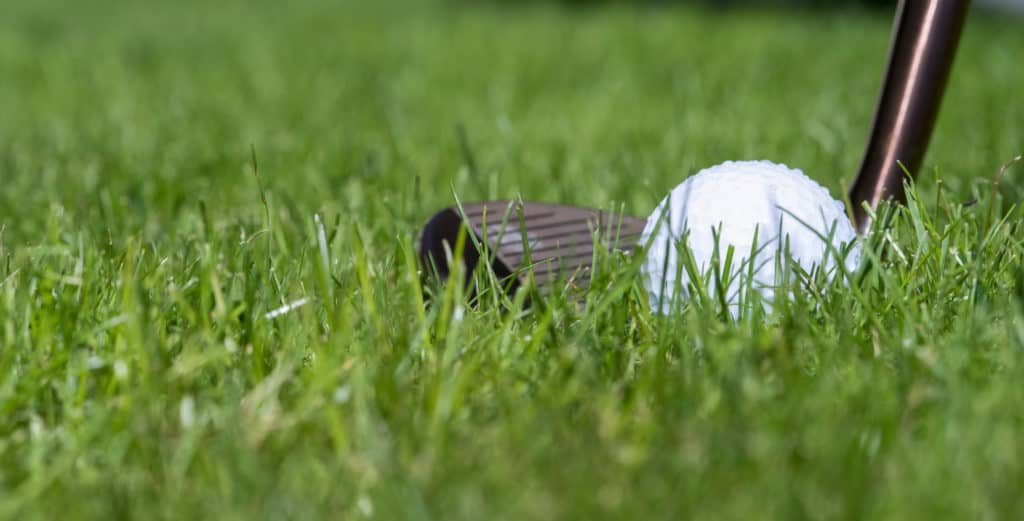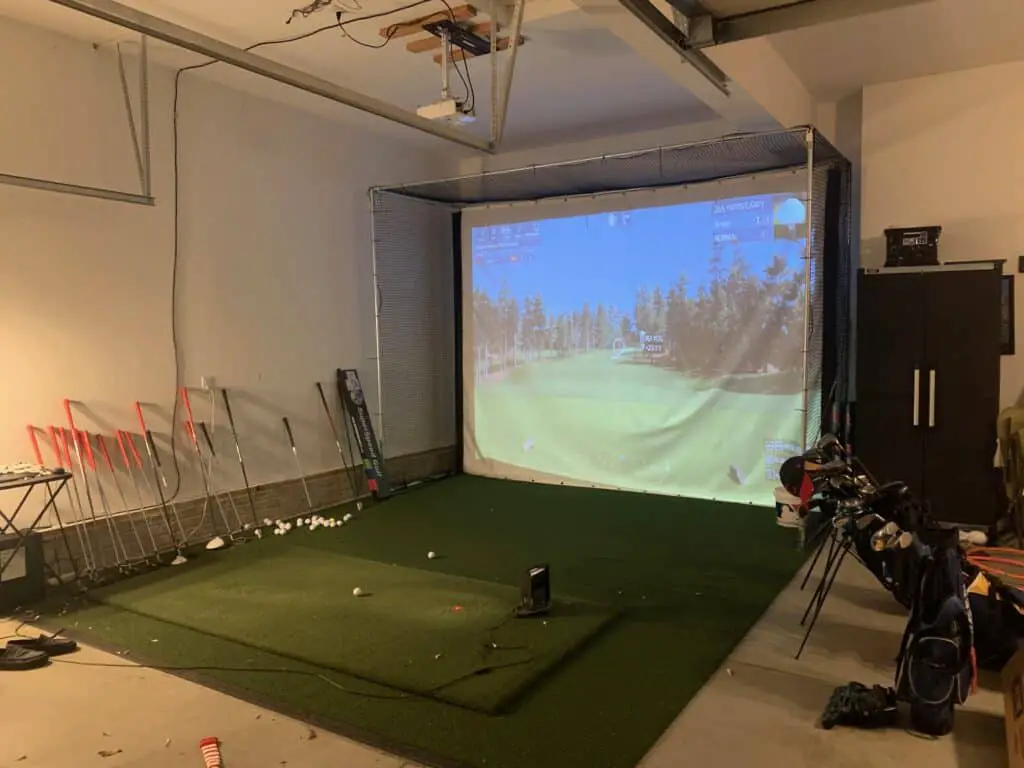5 tips to stop blading chip shots:
- Set up properly
- Use the bounce
- Keep your speed consistent
- Visualize the club sliding underneath the ball
- Build confidence
There is nothing worse in golf than having fear over a chip shot.
You are not alone if you struggle with this issue.
From the PGA Tour Pros to the worst golfers around, we have all stood over a chip shot at some point with some fear of either blading the shot or hitting it fat.
Some of the best golfers in the world have struggled with the yips at some point.
Does this sound familiar?
You miss a green with your approach shot. Right away you start feeling uneasy about the shot you have to hit. You rush up to the shot, take several practice swings and then approach the shot.
Through your mind runs all of the potential bad things that could happen. You start thinking of chunking the shot, or blading the shot or something really bad. You just about freeze over the shot before you finally start the backswing and next thing you know…you have a poor result.
How To Stop Blading Chip Shots
Update: Have you ever struggled to make solid contact no matter what you do? Do you chip with a little bit or maybe even a lot of fear? It might be time to try the split grip (see below) or left hand low chipping styles. Both can help re-set your approach and take away that little flinch at the bottom of the swing. Did you know that the 2022 US Open champion chipped with his left hand low? Maybe it is time to give it a shot! If it is good enough to win a US Open, maybe it is good enough for the amateur golfer!
Before we dive into the 5 tips, let’s first diagnose what takes place when a golfer blades a chip shot. This will help us better understand why the 5 tips above are so important to overall success with hitting quality chip shots.
What causes a bladed chip shot?
The bladed chip shot occurs when the golfer loses confidence during the downswing in the chipping motion and pulls his or her arms up into their body, raising the club which results in the bottom of the club hitting the middle to top of the ball.
The golfer most frequently fears or struggles with the anxiety and confidence of the interaction between the golf club and the ground. Oftentimes, the golfer that struggles with the bladed chip shot might also struggle from the chunk shot and is trying to save the embarrassment of the club hitting the ground 2-3 inches before the ball and stubbing the ground.
The golfer must learn to gain confidence in the ground/club interaction and not fear the ground. The tips below can help you maximize the right portion of the golf club (the bounce area) and start hitting some quality chip shots.
How to stop chunking chip shots

Tip #1: Set up properly to the ball
Where you struggle from chunking or blading, this setup position will help.
The golfer will want to keep the setup as neutral as possible. The ball should be just ahead of the center of the stance with the hands fairly equal to the ball. A golfer gets in trouble when the hands push too far ahead of the ball. This leads to the leading edge hitting the ground too soon or the golfer reacting and pulling the arms and clubhead up from the ground.
This brings the leading edge into play, which can be troublesome for many amateurs. It takes extra precision in the low point that many amateur golfers don’t have the time to practice enough.
Once you get into a proper setup the golfer just wants to take the club far enough and return to this similar setup position at impact, but continue the follow through past impact. You will want to work on three different speeds: a slow, a medium and a fast pace. Depending on how you feel that day, one might work the best depending on your fear level.
Struggling with the yips? Here are some helpful tips!
Tip #2: Use the bounce and envision the shot
You want to use the bounce to expand your margin of error. Once again, keep in mind that the bladed shot is often a result of the golfer fearing the chunked shot or from past experiences of chunking the ball while chipping.
You want to see the club sliding underneath the ball with the club continuing on past the ball to a balanced finish position. Being able to visualize the club just nipping the ground and continuing through will be essential to success. In your practice swings, don’t be afraid to find a similar type of lie somewhere near your ball and take some practice swings testing how the club will interact with the grass.
If you want a PGA Tour event, you will see the golfers rarely take a full swing on full shots, but will rehearse a chip shot 2-7 times. They are often building a feel and seeing how the club will interact with the ground and the grass.
The golfer that chops at the ball and uses the leading edge is going to struggle. Instead, you want to have the club slide underneath and use the bounce on the club to maximize your margin of error with your low point control on the chip shot.
The bounce will give your 2-3 inches of error compared to using the leading edge, which requires near perfection, especially on certain grasses or playing conditions.
Tip #3: Keep your speed constant
When a golfer gets nervous or anxious over a chip shot, they will frequently speed up too much through the shot. This causes the hands to move too far past the clubhead, which brings the leading edge into play, reducing the margin for error.
As that speed picks up, the golfer will often raise his or her arms, leading to the bladed chip shot.
Instead, feel like you keep the speed constant through the shot. Of course, there will be some extra speed as you start the downswing, but the feeling should be a constant control of the speed all the way to the finish.
When you are taking your practicing swings, determine the speed you will use and work on keeping it constant.
Slowing down or speeding up is a recipe for a chunked or bladed chip shot.
How to practice chipping at home (8 drills)
Tip #4: Visualize the club sliding underneath the ball
As you take your practice swing, imagine a ball sitting there on the grass and envision the club sliding through the grass and underneath the ball, producing a soft landing chp shot that will be a positive shot.
Control your self talk and the thoughts and have a positive mindset as your approach the shot. As your step up to the ball, work the feel you just developed, and maintain your speed throughout the shot.
Using the bounce when chipping
Tip #5: Build confidence
One of the keys to anything in golf is practicing enough so that when you take your game to the course, you are able to have confidence in the shots that a round of golf demands from you. It is almost guaranteed that you will hit at least 5-6 chip shots per round.
The short game is essential to your success and one of the fastest ways to improve your scores is to get really good at chipping the ball.
My favorite game at the practice green to build confidence and build up some pressure like situations in the short game is found directly below. Remember to practice your routine and stick with your practice swing before each shot.
- Take one golf ball
- Pick one random hole on the practicing green
- Hit the chip shot
- Go try to make the putt
- Track how many times out of 10 you can successfully hit one chip shot and make the one putt.
- Track over time to measure your progress
The goal with this game is to hit as many shots inside of 3 feet to make the one putt as simple as possible.

Alternative Chipping Grip: Use a Split Grip
You might think I am crazy, but you have to give it a shot. Several weeks ago, I was chipping some wiffle balls in my basement and started to mess around with different grips with chipping.
My thought process was the many different grips used for putting on the PGA Tour. You have back handed grips, you have golfers using the claw, you have belly putters, long putters, etc. If speed is not an issue with many chip shots, why do we have to default to a traditional grip when chipping?
So I placed my left hand at the end of the golf club towards my midsection and my right hand right before where the grip ends. So my right hand remained lower than my left hand, but there was a significant gap between my two hands.
I started hitting chips shots like this and found my mind at ease and the consistency was rather impressive. However, my thought process was this might never work on a golf course. So I practiced for the next week in my basement and then took it to my golf simulator set up in my garage and hit some quality chip shots. The next stage was to use it during a round on my golf simulator and I passed that test.
Now I am thinking, can this really work on a golf course? Fortunately, during the month of December the weather was warm enough to play a round of golf. I was anxious to attempt the split grip, chipping motion. Of course I go out and hit the first 8 greens in regulation and on the 9th hole I hit in the bunker. I used my normal grip out of the bunker. I then hit the 10th green in regulation, but leave my 8 iron short on number 11.
Here we go! It was a chip out of medium rough and I needed to carry the ball about 5 yards onto the green and another 7 or so yards of green was present. I used my 60 degree lob wedge and chipped it perfectly and it rolled within two feet of the hole for a tap in par. The next test had been passed.
On the very next hole, I hit a 130 yard wedge shot a bit short on the tight faraway approach area. Can I pull this off from a tight lie. I grabbed the 60 degree lob wedge again, placed it in the middle of my stanced, kept my motion simple and hit it within 1 foot. The rest of the round, I had 2 other opportunities and was successful on 1 out of those 2 for a total of 3 out of 4 scrambling using the split grip.
From where I will continue to practice and have used the following approach.
- Keep your stance simple
- Use 1 of 3 ball positions: back foot, middle of stance, front foot
- Use the bounce on the middle and front foot swings.
- Use a more aggressive swing with the ball on the back foot
I will continue to experiment and would encourage you to give it a shot! What do you have to lose? If you struggle with the chipping yips, you might be willing to give anything a chance at this point!
Final Thoughts: Why might golfers fail with the split grip
The bottom line is that much of the chipping yips comes from fear of embarrassment. There are plenty of golfers who can hit 30 great chip shots in a row around a practice green, but as soon as it matters and their friends or competitors are round, the worse comes out.
The golfers unwilling to put themselves out there, might be embarrassed to try this grip. My recommendation if you fall into this camp is to take the following steps to give it a shot.
- Practice around your house with wiffle balls
- Take to your backyard
- Take to the practice green
- Take it to the course
Make sure you build confidence and are willing to be proud of this approach! When you start hitting chip shots within 3 feet, your golf buddies might start asking for help!
Did you know that professional golfers have struggled with the chipping yips. Tiger Woods and Hal Sutton come to mind. Be confident in what works for your game and compare it to the many different putting grips that are used.
Adam Scott won the Masters with a long putter! You can use a split grip on your chips at your local golf course on the weekend! Be proud and hit some great shots! Your mind will be at ease as your head to the course with great confidence that you can hit quality chip shots.

My Secret To Golf Improvement
Let’s face it, in order to get really good at golf, we must practice frequently. About three years ago, I made the leap and invested in a golf simulator build for my garage. I went with a SkyTrak Launch Monitor and the TGC software and can now play over 100,000 courses including Augusta, Pebble Beach, Bethpage Black, Whistling Straits. St. Andrews and many other of the top 100 courses in the world.
This golf simulator setup, which is more affordable that you might imagine, has been a game changer. I can now play golf everyday of the year regardless of rain, snow, cold weather or time of day. I can practice or play rounds of golf. I can stand in the 11th fairway at Augusta and with the auto-rewind feature I am able to practice my approach shots from various differences.
It is worth checking out through Rain or Shine Golf as they offer some incredible packages along with financing offers that are difficult to beat.
Some direct links to Rain or Shine Golf for pricing and financing:
Take Action – What You Can Do Today to Get Better
What does this mean for you? I believe in the following recipe to get better:
1 – Improve your motion in the golf swing by identifying a golf instructor. Here are some options:
Here is a list of golf instructors that we have reviewed:
2 – Train to swing faster and improve your swing speed. Here are some options:
Looking to gain more Speed and Distance in your swing. Two Options:
3 – Understand course strategy and work to break through your next barrier. Here is a series on breaking through:
We have provided guides on how to break 100, 90, 80 and 70. Check out more below, if interested.
4 – Practice Frequently
Did you know that I build a golf simulator in my garage and have played over 500 rounds of golf on my SkyTrak system? It has been a game changer and one worth checking out. Here are some of my other posts on golf simulators frequently asked questions:
- Is a Golf Simulator Worth It?
- How to Build a Golf Simulator?
- What is the Best Golf Simulator?
- Golf Simulator Accessories?
- How to Build a Golf Simulator for under $7000
- Top 11 Reasons to Buy a SkyTrak
- How to Build a Golf Simulator for Under $1000
- Why Build A Golf Simulator?
- What Space is Needed?
- Can A Golf Simulator Improve My Game?
- How Much Does A Golf Simulator Cost?
- Don’t Forget to Check out our 15 best golf swings of all time.
